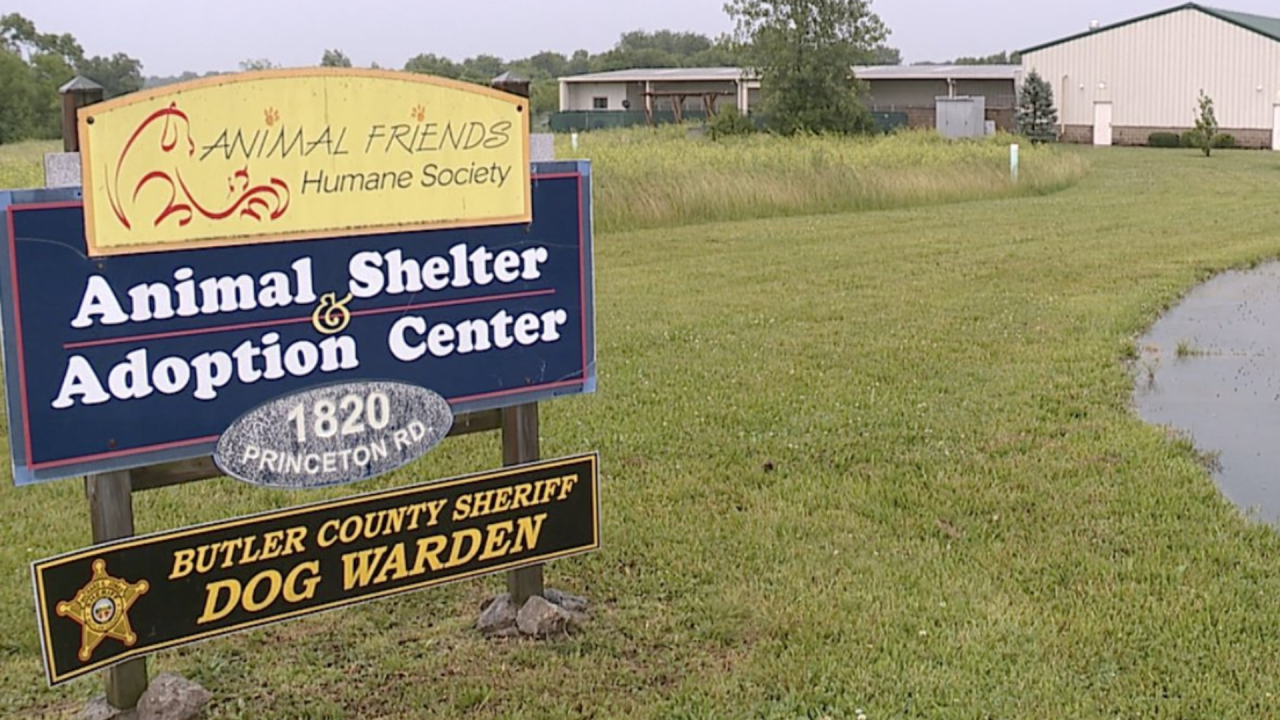CINCINNATI — Greater Cincinnati animal shelters euthanized nearly 1,700 dogs and cats in 2023. More than 60% of those deaths happened in Butler County.
Animal Friends Humane Society in Fairfield Township euthanized 574 dogs and 457 cats that year, according to data compiled by the WCPO 9 I-Team. That’s more than taxpayer-funded shelters in seven other counties combined.
Animal Friends also ranked second in the region, with 126 animals that died from disease or injury 2023. Cincinnati Animal Care in Hamilton County had 146 animals that died in its care, even though it took in about 1,000 more animals than Butler County that year.
But that wasn’t the only thing that made Butler County’s shelter stand out among its regional peers.
WATCH: The WCPO 9 I-Team compared local animal shelters on a variety of metrics here
It also ranked last in the region with $366.92 spent per animal in 2024, compared to average spending of $1,070 at shelters in Hamilton, Clermont, Warren, Boone, Kenton, Campbell and Dearborn counties.
Butler County's shelter also had the region's lowest "save rate," which the Best Friends Animal Society defines as "the percentage of animals who enter a shelter and leave the shelter alive." Shelters with a save rate above 90% are considered "no kill" shelters. Animal Friends had a 77.6% save rate in 2024.
“If you see that you’re spending less money than other communities around and it’s having a negative impact on your save rate, I think two things,” said Brent Toellner, senior director of lifesaving programs for Best Friends. “Number one, you need to look at, ‘Do we need to spend more to solve this problem?’ Number two, ‘Do we need stability in leadership and a vision to make that justifiable to our public?’”

The I-Team has been looking into the operations of local animal shelters because it’s a system under stress. Many shelters are at full capacity because adoptions have declined since 2019 while shelter stays have lengthened, particularly for dogs, according to a 2024 report by Shelter Animals Count. That’s putting pressure on local governments and nonprofits to fund improvements to shelters that were designed for shorter stays and more euthanasia.
“The way we spend our tax dollars is a reflection on how our community and how our society values what we spend the money on,” Toellner said. “And I think, by and large, communities have said … pets shouldn’t be killed and seen as disposable.”
Butler County’s euthanasia numbers include 408 deaths from “owner-intended euthanasia,” a once-common practice that has fallen out of favor in the industry. In fact, a 2021 report by Best Friends said they now account for less than 2% of shelter outcomes.
Animal Friends declined to do an interview but provided a statement saying owners request euthanasia for critically ill and injured pets.
"The shelter has a long history of providing these services to the community," the email stated. "Comparing the shelter’s numbers to other area shelters is quite misleading, since other shelters either do not provide these services nor do they report them in their total numbers."
Toellner said owner-initiated euthanasia should be counted because they are animal deaths, not live outcomes.
Butler County Administrator Judi Boyko declined to comment on the euthanasia stats. But she said the county’s lease and operating agreements will expire with Animal Friends at the end of this year.
“Topics for discussion will inevitably be funding, continuous improvements in operations, and building maintenance,” Boyko said in an email response to the I-Team’s questions. “All parties will approach those expiring agreements in the interest to continuously improve operations, care for the animals entrusted to the shelter, and appreciative recognition of the hundreds of volunteers, dedicating their times and hearts.”

Why look at this now?
The I-Team’s analysis comes at a time of increased spending by counties and increased engagement by animal lovers.
Boone County opened an $8 million shelter last year. Hamilton County is planning a new shelter on Winton Road that could cost more than $40 million. Clermont County boosted its operating budget by 22% this year to $1.25 million. It also welcomed a new leader. Kiarah Swartz is a former deputy dog warden who was operations manager for the Brown County Humane Society before joining Clermont as shelter administrator in April.
Clermont’s county-operated, dogs-only shelter came under fire last summer, when volunteers went public with concerns about the facility’s cleanliness and a lack of training and leadership for the staff.
“We are running into the same diseases every day,” Jennifer Jacobsen told WCPO last August. “There’s really no person in charge to help anybody make decisions.”
Hamilton County’s shelter was criticized in March for not removing two dogs from a Colerain Township neighborhood after they caused serious bite injuries by attacking a mother of three.
“I can’t believe I did not die,” Emily Rentschler told WCPO at the time. “I’m very terrified. We’ve already discussed, ‘Do we need to move?’”
Beth Ward, who serves as Hamilton County’s dog warden through a contract with Cincinnati Animal Care Humane Society, told Hamilton County Commissioners that her deputies determined the owners could safely quarantine the dogs in their home. But the owners later surrendered the dogs to the shelter and arranged to have them euthanized.
In Butler County, the Animal Friends was criticized this month by community supporters, after it admitted euthanizing several kittens following an outbreak of panleukopenia, a highly contagious and sometimes fatal disease.
Southwest Ohio Feline Advocates President Michele DeCresce told WCPO the shelter could have confined the outbreak without killing cats and wasn’t transparent about the number of cats killed.
“I was absolutely shocked by that,” DeCresce said. “The protocol is cleaning.”
Butler County’s struggles
Established in 1952, the Animal Friends Humane Society racked up $581,000 in operating losses between 2021 and 2023, according to its tax returns. In 2022, a volunteer treasurer admitted stealing more than $700,000 from the organization.
Butler County court records indicate most of that money has yet to be recovered. Another former Animal Friends volunteer said the funding gaps are evident.
“This is nobody’s fault but everybody’s problem,” said Chad Teets. “The system’s challenged. The system’s underfunded.”
Teets is a Fairfield resident who watched four directors come and go during three years of service in Butler County. He left in March because he grew frustrated with the lack of kennel space and other issues.
“You can’t just put these dogs in kennels and leave them there,” Teets said. “That’s not humane treatment and it’s not fair to them. These dogs need to get out. They need to be walked. They need human interaction.”
Before he left, Teets adopted Romi, a Shar-Pei Pitbull mix he’d been fostering. He still thinks highly of the people he met at the shelter but hopes Butler County will make new investments and insist on better outcomes for the animals he left behind.

Building boom
Other counties are already doing so.
Boone County opened its $8 million shelter in March 2024, enabled by $3 million in private donations. The 16,000-square-foot building houses the same number of animals as the old building, roughly 100. But it has state-of-the-art features designed to improve health outcomes for dogs and cats.
“The dogs can’t see the cats when they’re in their environment. They can’t smell them. They can’t hear them. And it’s the same for the cats,” said Coleen Bray, director of the Boone County Animal Shelter. “Cats have a lot of floor space, a lot of vertical space and they have natural light in all their kennels. And we very rarely have to treat a cat for upper respiratory disease.”
To minimize infections, dogs and cats have their own air-handling systems.
“There are eight rooftop units on this facility,” Bray said. “So, the clinic and the surgery suite has its own air exchanges, properly configured for that type of space. Cats have their own unit on the top of the building and the dogs do too.”
Hamilton County made a massive new investment by signing a contract for up to 10 years with Cincinnati Animal Care. Not only will it boost annual subsidies to more than $5 million, but it calls for construction of two new facilities that the county expects will cost more than $40 million.
Cincinnati Animal Care wouldn’t answer questions about its contract, but provided a statement, which includes:
“The medical team at CAC consists of more than 30 medical professionals, enabling an unmatched level of on-site surgical and urgent care, never before provided in Hamilton County, which saves both lives and money. Additionally, CAC has both a robust foster program, a proven necessity in progressive, community-supported animal sheltering, and a professional behavior and training team that evaluates every dog entering the shelter, testing for temperament and developing individual training plans. Together, these programs help facilitate live outcomes for the more than 9,000 animals we serve every year, resulting in more than 20,000 successful adoptions in the past five years.”
Methodology
The numbers in this story came primarily from three sources: Best Friends Animal Society, county budget documents and IRS 990 forms for the four nonprofits that operate county shelters under county contracts. Best Friends provided save rate and animal intake data for Butler, Hamilton, Boone, Campbell and Dearborn counties. The I-Team estimated save rates for Clermont, Warren and Kenton counties using intake data provided by the shelters. To arrive at that number, we divided the total number of live outcomes by total intake. Live outcome numbers, not provided in the chart above, included animals adopted, returned to owners or transferred to other agencies. Spending data came from county budget estimates or actual spending totals provided by counties for the 12 months ending June 30, 2024. Nonprofit spending numbers came from tax returns for the 2023 calendar year, the most recent year available. The taxpayer percentage was calculated by dividing nonprofit spending into taxpayer spending. Per capita spending was calculated by dividing each county’s taxpayer spending into its 2023 population.




